Establishing Boundary Conditions Considering Influence Factors of the Room Equipped with a Ceiling Radiant Cooling Panel
Abstract
:1. Introduction
2. Preliminary Study
2.1. Types of CRCP
2.2. Current Evaluation Method of the Cooling Capacity of the CRCP
2.3. Concept for Establishing Boundary Condition
3. Environment of Room Equipped with CRCP
3.1. Heat Transfer Model of Room Equipped with CRCP
3.2. Influencing Factors of Cooling Capacity
3.3. Values and Ranges of Influencing Factors
4. Evaluation of Boundary Condition of the CRCP Equipped Room
4.1. Concept of the Boundary Condition Derivation Model
4.2. Simulation Model for Evaluating Boundary Condition
4.3. Simulation Results
4.3.1. Boundary Conditions on Wall Composition
- Material and composition of wall
- Heat transmission coefficient of wall
- Surface heat absorption rate of wall
4.3.2. Boundary Conditions on Site and Building
- Sol-air temperature
- Number of surfaces exposed to outdoor air
4.3.3. Boundary Conditions on Internal Heat Gain
- Amount of internal heat gain
- Component of internal heat gain
4.4. Impact Analysis of Factors
5. Cooling Capacity According to Boundary Condition
5.1. Evaluation of Cooling Capacity According to Boundary Condition
5.2. Evaluation Results of Cooling Capacity
5.3. Verification Experiment of Boundary Condition Derivation Model
6. Conclusions
Author Contributions
Funding
Acknowledgments
Conflicts of Interest
References
- Imanari, T.; Omori, T.; Bogaki, K. Thermal comfort and energy consumption of the radiant ceiling panel system. Comparison with the conventional all-air system. Energy Build. 1999, 30, 167–175. [Google Scholar] [CrossRef]
- Antonopoulos, K.A.; Vrachopoulos, M.; Tzivanidis, C. Experimental evaluation of energy savings in air-conditioning using metal ceiling panels. Appl. Therm. Eng. 1998, 18, 1129–1138. [Google Scholar] [CrossRef]
- Fonseca, N. Experimental study of thermal condition in a room with hydronic cooling radiant surfaces. Int. J. Refrig. 2011, 34, 686–695. [Google Scholar] [CrossRef]
- ANSI/ASHRAE. Standard 138-2009, Method of Testing for Rating Ceiling Panels for Sensible Heating and Cooling; American National Standards Institute/American Society of Heating, Refrigerating and Air-Conditioning Engineers: Atlanta, GA, USA, 2009. [Google Scholar]
- Comité Européen de Normalisation (CEN). Water Based Surface Embedded Heating and Cooling Systems—Part 2: Floor Heating: Prove Methods for the Determination of the Thermal Output Using Calculation and Test Methods; Standard EN 1264-2; Comité Européen de Normalisation: Brussels, Belgium, 2012. [Google Scholar]
- Babiak, J.; Olesen, B.W.; Petras, D. Low Temperature Heating and High Temperature Cooling: REHVA Guidebook No. 7; Federation of European Heating, Ventilation and Air Conditioning Associations: Brussels, Belgium, 2007. [Google Scholar]
- ASHRAE. 2016 ASHRAE Handbook -HVAC Systems and Equipment, Ch.6 Radiant Heating and Cooling; American Society of Heating, Refrigerating and Air-Conditioning Engineers: Atlanta, GA, USA, 2016. [Google Scholar]
- LBNL. Development of a Simulation Tool to Evaluate the Performance of Radiant Cooling Ceilings; CIEE Report; LBNL: Berkeley, CA, USA, 1995; p. 138. [Google Scholar]
- Kochendorfer, C. Standardized testing of cooling panels and their use in system planning. Ashrae Trans. Symp. 1996, 102, 651–658. [Google Scholar]
- Fonseca, N.; Cuevas, C.; Lemort, V. Radiant ceiling systems coupled to its environment part 1: Experimental analysis. Appl. Therm. Eng. 2010, 30, 2187–2195. [Google Scholar] [CrossRef]
- De Carli, M.; Scarpa, M.; Tomasi, R.; Zarrella, A. A numerical model for the thermal balance of rooms equipped with radiant systems. Build. Environ. 2012, 57, 126–144. [Google Scholar] [CrossRef]
- Tian, Z.; Yin, X.; Ding, Y.; Zhang, C. Research on the actual cooling performance of ceiling radiant panel. Energy Build. 2012, 47, 636–642. [Google Scholar] [CrossRef]
- Comité Européen de Normalisation (CEN). Ventilation for Buildings–Chilled Ceilings–Testing and Rating Offers a Testing Method for Chilled Ceilings; British Standard EN14240:2004; Comité Européen de Normalisation: Brussels, Belgium, 2004. [Google Scholar]
- Nordic. Ceiling Cooling Systems: Cooling Capacity (NT VVS 078); Nordic: Oslo, Norway, 2001. [Google Scholar]
- ASHRAE. 2013 Handbook -Fundamentals, Ch. 18 Nonresidential Cooling and Heating Load Calculations; American Society of Heating, Refrigerating and Air-Conditioning Engineers: Atlanta, GA, USA, 2013. [Google Scholar]
- Mills, A.F. Basic Heat & Mass Transfer; Prentice Hall: Saddle River, NJ, USA, 1999. [Google Scholar]
- Chantrasrisalai, C.; Fisher, D.E. Lighting Heat Gain Distribution in Buildings (RP-1282); ASHRAE Research Project, Final Report; ASHRAE: Atlanta, GA, USA, 2006. [Google Scholar]
- Winkins, C.; Hosni, M.H. Heat gain from office equipment. Ashrae J. 2000, 42, 33–44. [Google Scholar]
- LBNL. ENERGYPLUS Input Output Reference. LBNL 2013, 11, 1–3. [Google Scholar]
- Ryu, S.R.; Rhee, K.N.; Yeo, M.S.; Kim, K.W. Strategies for flow rate balancing in radiant floor heating systems. Build. Res. Inf. 2008, 36, 625–637. [Google Scholar] [CrossRef]
- Jeong, J.W.; Mumma, S.A. Ceiling radiant cooling panel capacity enhanced by mixed convection in mechanically ventilated spaces. Appl. Therm. Eng. 2003, 23, 2293–2306. [Google Scholar] [CrossRef]
- Jeong, J.W.; Mumma, S.A. Simplified cooling capacity estimation model for top insulated metal ceiling radiant cooling panels. Appl. Therm. Eng. 2004, 24, 2055–2072. [Google Scholar] [CrossRef]
- Park, S.H.; Kim, D.W.; Yeo, M.S.; Kim, K.W. An Experiment for Estimating the Cooling Capacity of the Radiant Ceiling Panel System. J. Archit. Inst. Korea Plan. Des. 2014, 30, 267–276. [Google Scholar] [CrossRef]
- Kim, T.Y.; Kato, S.; Murakami, S.; Rho, J.W. Study on indoor thermal environmental of office space controlled by cooling panel system using field measurement and the numerical simulation. Build. Environ. 2005, 40, 301–310. [Google Scholar] [CrossRef]
- Lim, J.H.; Jo, J.H.; Kim, Y.Y.; Yeo, M.S.; Kim, K.W. Application of the control methods for radiant floor cooling system in residential buildings. Build. Environ. 2006, 41, 60–73. [Google Scholar] [CrossRef]
- Miriel, J.; Serres, L.; Trombe, A. Radiant ceiling panel heating-cooling systems: Experimental and simulated study of the performances, thermal comfort and energy consumptions. Appl. Therm. Eng. 2002, 22, 1861–1873. [Google Scholar] [CrossRef]
- Shin, M.S.; Rhee, K.N.; Park, S.H.; Yeo, M.S.; Kim, K.W. Enhancement of cooling capacity through open-type installation of cooling radiant ceiling panel systems. Build. Environ. 2019, 148, 417–432. [Google Scholar] [CrossRef]

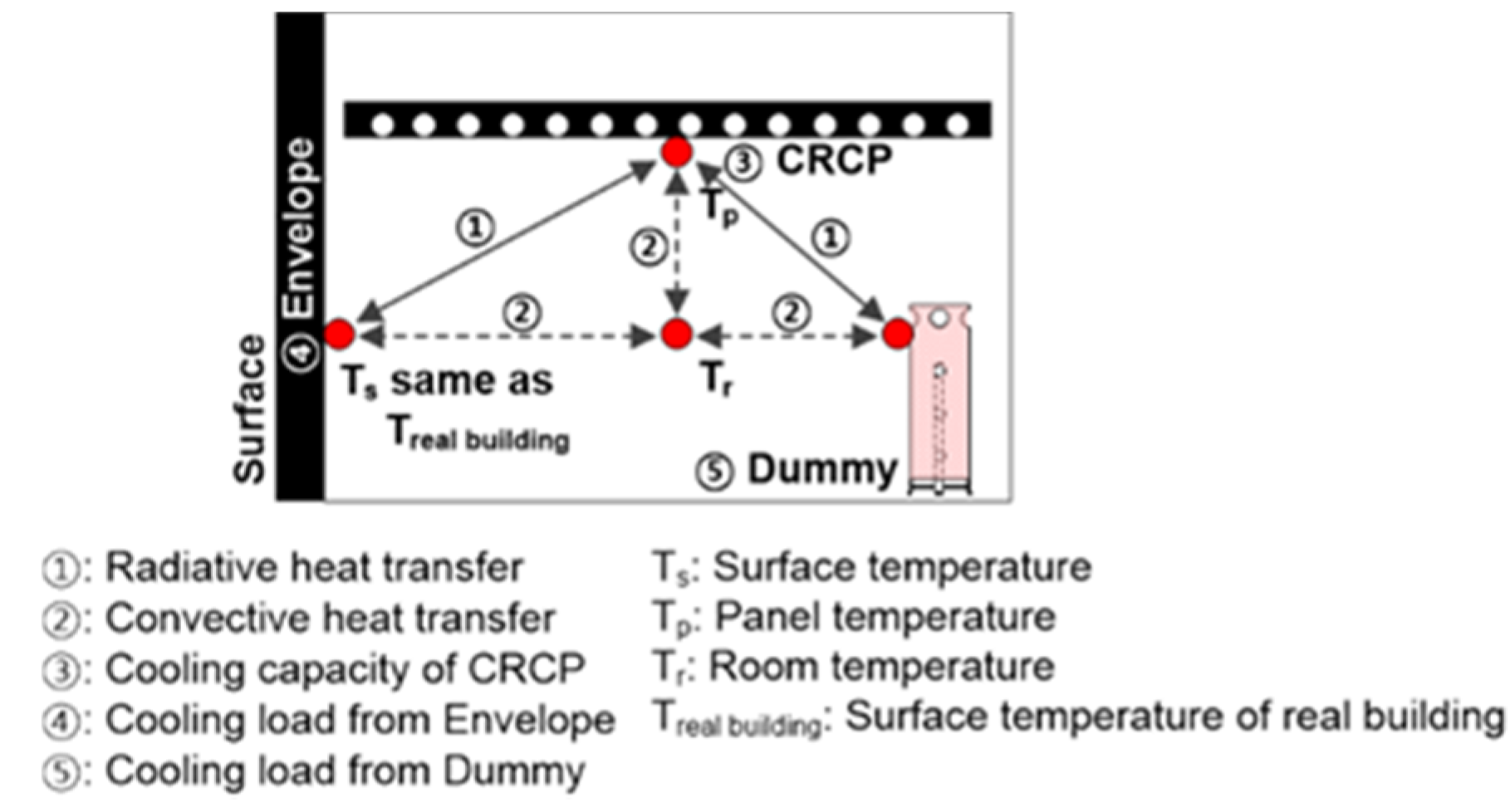
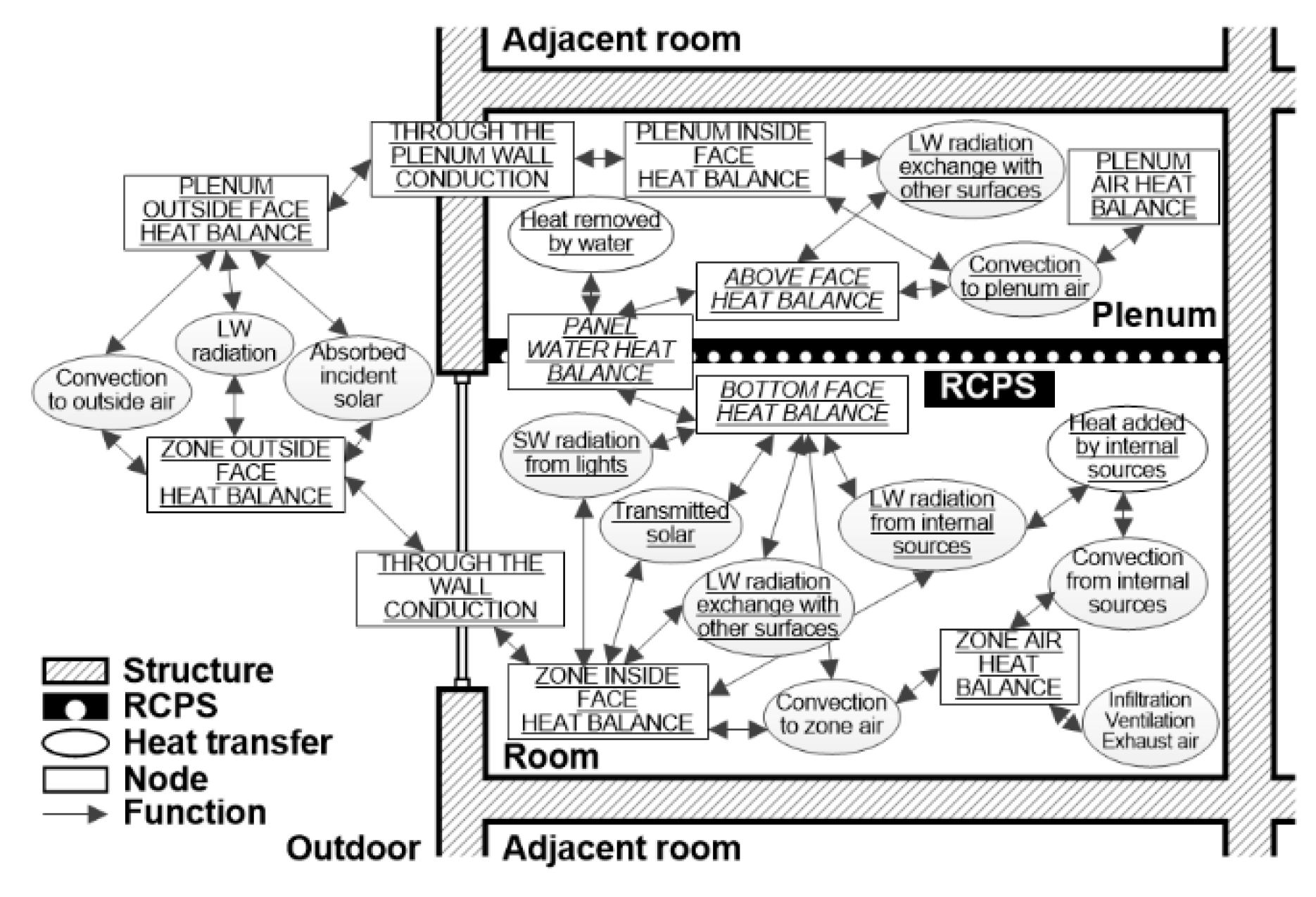












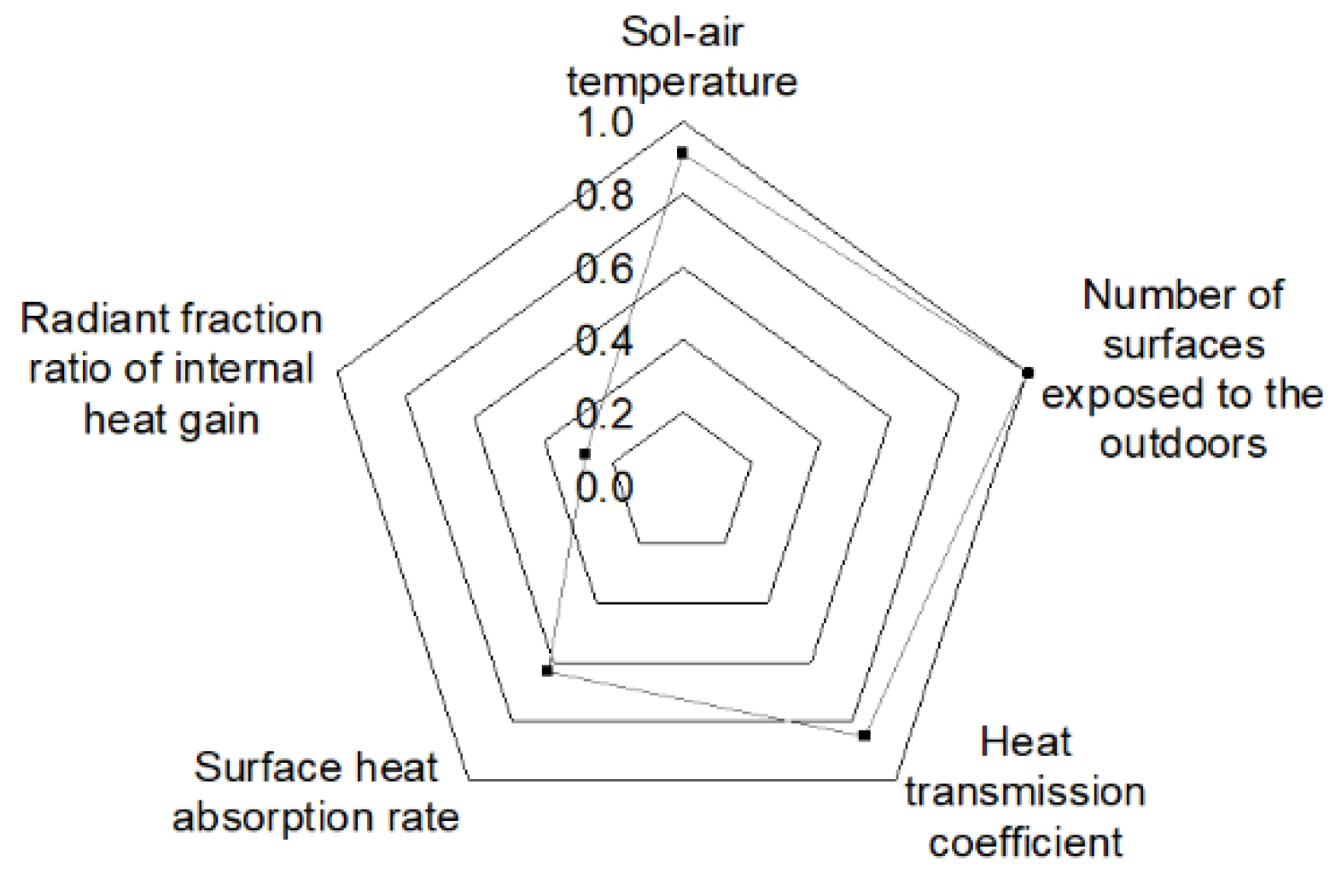
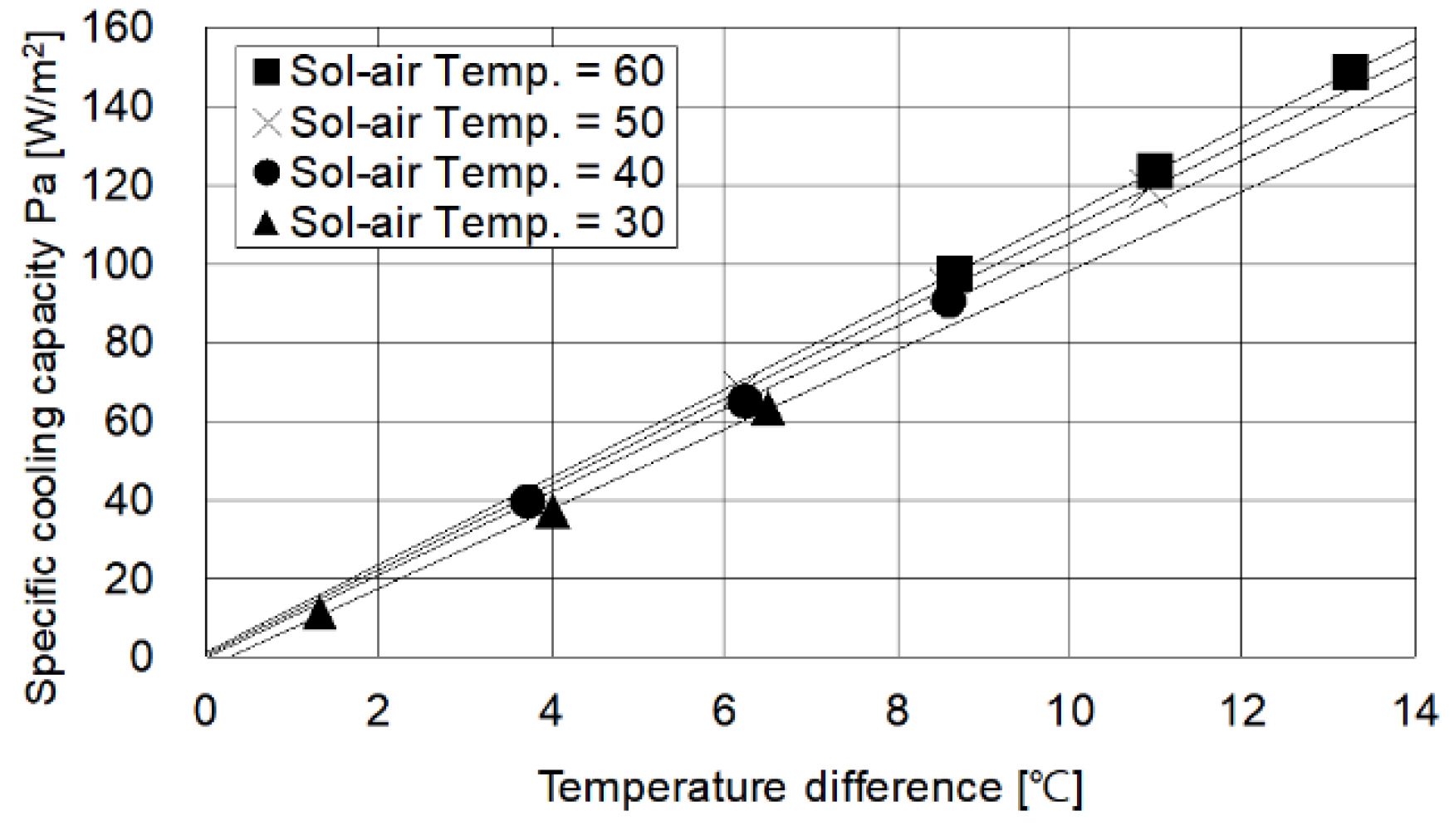

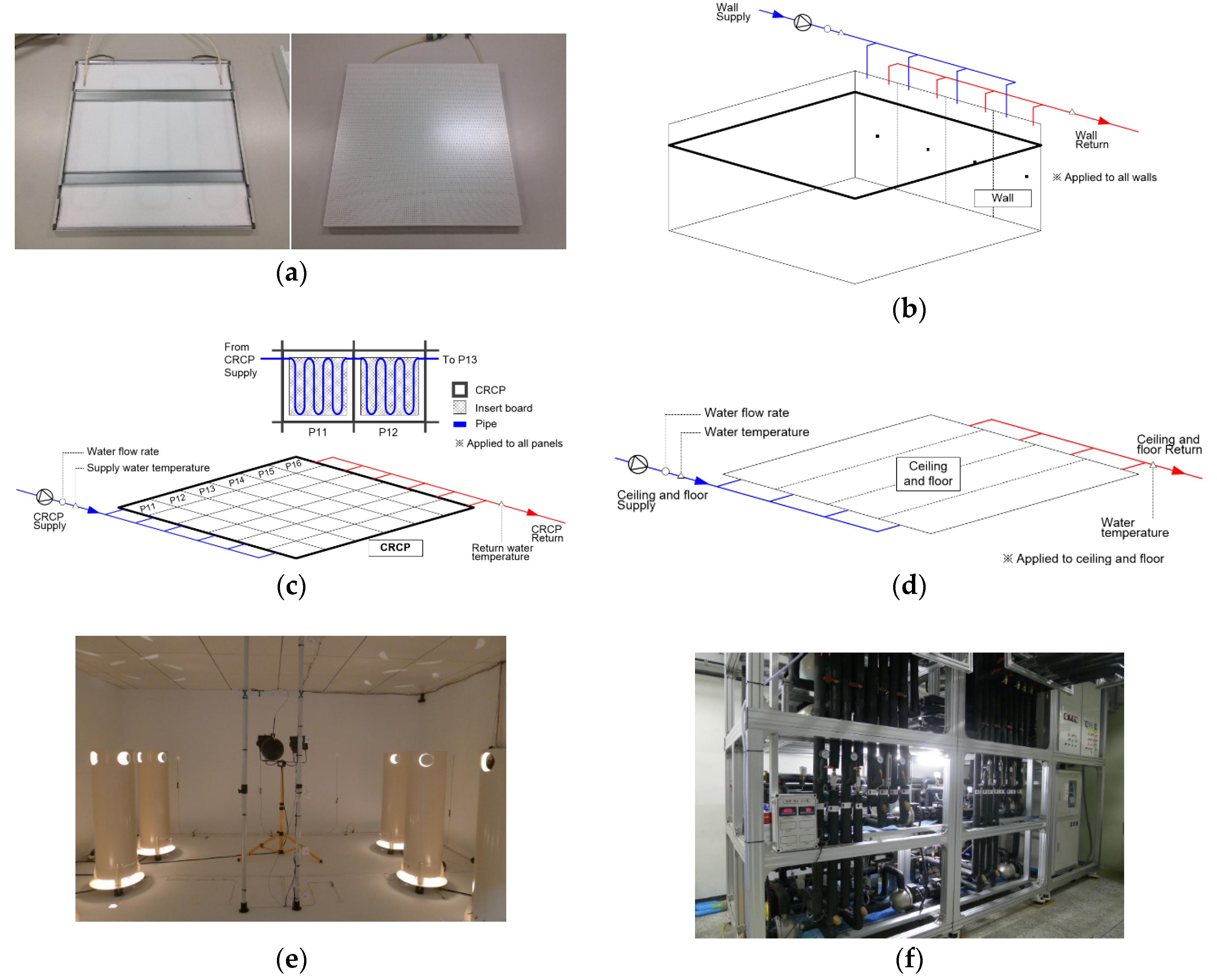

| Research | Section Type | Conceptual Diagram |
|---|---|---|
| ASHRAE | A temperature-controlled surface is referred to as a radiant panel if 50% or more of the design heat transfer on the temperature-controlled surface takes place via thermal radiation [7]. |  |
| REHVA | Radiant heating and cooling systems are panels with integrated pipes suspended under the ceiling [6]. | |
| This study | The Cooling Radiant Ceiling Panel hangs on the ceiling and exchanges thermal radiation by radiant heat transfer. Since the piping is biased in the room side direction, radiation occurs in a target space. |  |
| Contents | LBNL Study [8] | ASHRAE [7] |
|---|---|---|
| Concept | Heat exchange among temperature-controlled (active) surfaces, room surfaces, and room air Sum of convective and radiative heat transfer | |
| Equation | ||
| Symbol | : sum of convective and radiant heat transfer : heat transfer by convection : heat transfer by radiation : convective coefficient : room air temperature : surface temperature : Stefan–Boltzmann constant : configuration factor : emissivity factor : mean radiant temperature (MRT) of unconditioned surface : mean radiant temperature (MRT) of cooled surface | : effective temperature of temperature-controlled surface : indoor space dry-bulb air temperature : equivalent diameter of panel : total radiosity leaving or reaching panel surface : radiation angle factor between panel surface and another surface in room : radiosity from or to another surface in room : number of surfaces in room other than panels |
| Author or Organization | Issues |
|---|---|
| C. Kochendorfer [9] | Evaluates the cooling capacity in an environment where there is no heat exchange with the outside The amount of cooling capacity may vary, based on the surface temperature of the wall |
| N. Fonseca [3] N. Fonseca et al. [10] | Estimates the cooling capacity of the panel based on the external load |
| M. De Carli et al. [11] | The cooling capacity of the ceiling radiation panel is estimated using unsteady state analysis in consideration of the external load |
| Z. Tian et al. [12] | The cooling capacity of the panel is calculated based on the window to the wall ratio considering the influence of the window-installed envelope |
| EN14240 [13] | Since the material enclosing the CRCP could affect the cooling capacity of the panel, the adiabatic boundary condition is maintained to prevent the influence of the envelope |
| NT VVS 078 [14] | Same as EN14240 |
| Groups | Influencing Factors |
|---|---|
| Group 1: Site and building | Sol-air temperature |
| Number of surfaces exposed to the outdoors | |
| Group 2: Wall composition | Material and composition of wall |
| Heat transmission coefficient | |
| Surface heat absorption rate | |
| Group 3: Internal heat gain | Component of internal heat gain |
| Amount of internal heat gain |
| Groups | Factors | Unit | Value and Range |
|---|---|---|---|
| Group 1 | Sol-air temperature | (°C) | 30 40 50 60 |
| Number of surfaces exposed to the outdoors | (-) | 1 2 3 4 | |
| Group 2 | Material and composition of wall | (-) | Lightweight Heavyweight Outside-insulation Inside-insulation |
| Heat transmission coefficient | (W/m2K) | 2.02 0.66 0.39 0.22 0.15 | |
| Surface heat absorption rate | (-) | 0.1 0.6 0.9 | |
| Group 3 | Component of internal heat gain: Radiant Fraction | (-) | 1.0 0.6 0.0 |
| Amount of internal heat gain | (W) | 59 235 411 |
| Factors | Composition (Outside to Inside) | Specifications | ||||
|---|---|---|---|---|---|---|
| Thickness | Specific Heat | Conductivity | Surface Heat Absorption Rate | Heat Transmission Coefficient | ||
| (m) | (J/kgK) | (W/mK) | (-) | (W/m2K) | ||
| Inside insulated wall | Concrete 100 | 0.1 | 836.8 | 1.311 | 0.1 | 2.02 |
| Insulation 13 | 0.013 | 265 | 0.049 | 0.1 | ||
| Outside insulated wall | Insulation 13 | 0.013 | 265 | 0.049 | 0.1 | 2.02 |
| Concrete 100 | 0.1 | 836.8 | 1.311 | 0.1 | ||
| Concrete wall | Concrete 450 | 0.45 | 836.8 | 1.311 | 0.1 | 2.02 |
| Insulation wall | Insulation 17 | 0.017 | 265 | 0.049 | 0.1 | 2.02 |
| Factors | Composition (Outside to Inside) | Specifications | ||||
|---|---|---|---|---|---|---|
| Thickness | Specific Heat | Conductivity | Surface Heat Absorption Rate | Heat Transmission Coefficient | ||
| (m) | (J/kgK) | (W/mK) | (-) | (W/m2K) | ||
| U_2.02 | Insulation 316.8 | 0.3168 | 265 | 0.049 | 0.1 | 2.02 |
| U_0.66 | Insulation 216.8 | 0.2168 | 265 | 0.049 | 0.1 | 0.66 |
| U_0.39 | Insulation 116.8 | 0.1168 | 265 | 0.049 | 0.1 | 0.39 |
| U_0.22 | Insulation 66.8 | 0.0668 | 265 | 0.049 | 0.1 | 0.22 |
| U_0.15 | Insulation 17 | 0.0168 | 265 | 0.049 | 0.1 | 0.15 |
| Step | Modeling Process |
|---|---|
| 1 | Set simulation input variables |
| 2 | Configure the main room and the adjacent room to set the desired influencing factors on the space |
| 3 | Derive the thermal load to be eliminated to maintain the space to the set-point room temperature |
| 4 | Determine the supply water temperature and water flow rate to eliminate the thermal load |
| 5 | Calculate and reset the supply water temperature to maintain the set point room temperature |
| 6 | Evaluate the boundary condition during the operation of the CRCP |
| Cases | Group 1 | Group 2 | Group 3 | |||||
|---|---|---|---|---|---|---|---|---|
| Sol-Air Temp. | Number of Faces Exposed to Outdoor Air | Material and Composition | Thickness | Heat Transmission Coefficient | Surface Heat Absorption Rate | Radiant Fraction | Heat Amount | |
| (°C) | (-) | (-) | (m) | (W/m2K) | (-) | (-) | (W) | |
| In_Ins | 60 | 1 | Concrete 100 (Outside) | 0.1 | 2.02 | 0.1 | 0.6 | 411 |
| 50 | ||||||||
| 40 | Insulation 13 (Inside) | 0.013 | ||||||
| 30 | ||||||||
| Out_Ins | 60 | 1 | Insulation 13 (Outside) | 0.013 | 2.02 | 0.1 | 0.6 | 411 |
| 50 | ||||||||
| 40 | Concrete 100 (Inside) | 0.1 | ||||||
| 30 | ||||||||
| Conc_Wall | 60 | 1 | Concrete 450 | 0.45 | 2.02 | 0.1 | 0.6 | 411 |
| 50 | ||||||||
| 40 | ||||||||
| 30 | ||||||||
| Ins_Wall | 60 | 1 | Insulation 17 | 0.017 | 2.02 | 0.1 | 0.6 | 411 |
| 50 | ||||||||
| 40 | ||||||||
| 30 | ||||||||
| Cases | Group 1 | Group 2 | Group 3 | |||||
|---|---|---|---|---|---|---|---|---|
| Sol-Air Temp. | Number of Faces Exposed to Outdoor Air | Material and Composition | Thickness | Heat Transmission Coefficient | Surface Heat Absorption Rate | Radiant Fraction | Heat Amount | |
| (°C) | (-) | (-) | (m) | (W/m2K) | (-) | (-) | (W) | |
| U_2.02 | 60 | 1 | Insulation 17 | 0.017 | 2.02 | 0.1 | 0.6 | 411 |
| 50 | ||||||||
| 40 | ||||||||
| 30 | ||||||||
| U_0.66 | 60 | 1 | Insulation 66.8 | 0.0668 | 0.66 | 0.1 | 0.6 | 411 |
| 50 | ||||||||
| 40 | ||||||||
| 30 | ||||||||
| U_0.39 | 60 | 1 | Insulation 116.8 | 0.1168 | 0.39 | 0.1 | 0.6 | 411 |
| 50 | ||||||||
| 40 | ||||||||
| 30 | ||||||||
| U_0.22 | 60 | 1 | Insulation 216.8 | 0.2168 | 0.22 | 0.1 | 0.6 | 411 |
| 50 | ||||||||
| 40 | ||||||||
| 30 | ||||||||
| U_0.15 | 60 | 1 | Insulation 316.9 | 0.3168 | 0.15 | 0.1 | 0.6 | 411 |
| 50 | ||||||||
| 40 | ||||||||
| 30 | ||||||||
| Cases | Group 1 | Group 2 | Group 3 | |||||
|---|---|---|---|---|---|---|---|---|
| Sol-Air Temp. | Number of Faces Exposed to Outdoor Air | Material and Composition | Thickness | Heat Transmission Coefficient | Surface Heat Absorption Rate | Radiant Fraction | Heat Amount | |
| (°C) | (-) | (-) | (m) | (W/m2K) | (-) | (-) | (W) | |
| Abs._0.1 | 60 | 1 | Insulation 17 | 0.017 | 2.02 | 0.1 | 0.6 | 411 |
| 50 | ||||||||
| 40 | ||||||||
| 30 | ||||||||
| Abs._0.6 | 60 | 1 | Insulation 17 | 0.017 | 2.02 | 0.6 | 0.6 | 411 |
| 50 | ||||||||
| 40 | ||||||||
| 30 | ||||||||
| Abs._0.9 | 60 | 1 | Insulation 17 | 0.017 | 2.02 | 0.9 | 0.6 | 411 |
| 50 | ||||||||
| 40 | ||||||||
| 30 | ||||||||
| Cases | Group 1 | Group 2 | Group 3 | |||||
|---|---|---|---|---|---|---|---|---|
| Sol-Air Temp. | Number of Faces Exposed to Outdoor Air | Material and Composition | Thickness | Heat Transmission Coefficient | Surface Heat Absorption Rate | Radiant Fraction | Heat Amount | |
| (°C) | (-) | (-) | (m) | (W/m2K) | (-) | (-) | (W) | |
| Sol_60 | 60 | 1 | Insulation 17 | 0.017 | 2.02 | 0.1 | 0.6 | 411 |
| 235 | ||||||||
| 59 | ||||||||
| Sol_50 | 50 | 1 | Insulation 66.8 | 0.0668 | 0.66 | 0.1 | 0.6 | 411 |
| 235 | ||||||||
| 59 | ||||||||
| Sol_40 | 40 | 1 | Insulation 116.8 | 0.1168 | 0.39 | 0.1 | 0.6 | 411 |
| 235 | ||||||||
| 59 | ||||||||
| Sol_30 | 30 | 1 | Insulation 216.8 | 0.2168 | 0.22 | 0.1 | 0.6 | 411 |
| 235 | ||||||||
| 59 | ||||||||
| Cases | Group 1 | Group 2 | Group 3 | |||||
|---|---|---|---|---|---|---|---|---|
| Sol-Air Temp. | Number of Faces Exposed to Outdoor Air | Material and Composition | Thickness | Heat Transmission Coefficient | Surface Heat Absorption Rate | Radiant Fraction | Heat Amount | |
| (°C) | (-) | (-) | (m) | (W/m2K) | (-) | (-) | (W) | |
| IHG._59 | 60 | 1 | Insulation 17 | 0.017 | 2.02 | 0.1 | 0.0 | 59 |
| 0.2 | ||||||||
| 0.4 | ||||||||
| 0.6 | ||||||||
| 0.8 | ||||||||
| 1.0 | ||||||||
| IHG._0.6 | 60 | 1 | Insulation 17 | 0.017 | 2.02 | 0.1 | 0.0 | 235 |
| 0.2 | ||||||||
| 0.4 | ||||||||
| 0.6 | ||||||||
| 0.8 | ||||||||
| 1.0 | ||||||||
| IHG._0.9 | 60 | 1 | Insulation 17 | 0.017 | 2.02 | 0.1 | 0.0 | 411 |
| 0.2 | ||||||||
| 0.4 | ||||||||
| 0.6 | ||||||||
| 0.8 | ||||||||
| 1.0 | ||||||||
| Cases | Group 1 | Group 2 | Group 3 | |||||
|---|---|---|---|---|---|---|---|---|
| Sol-Air Temp. | Number of Faces Exposed to Outdoor Air | Material and Composition | Thickness | Heat Transmission Coefficient | Surface Heat Absorption Rate | Radiant Fraction | Heat Amount | |
| (°C) | (-) | (-) | (m) | (W/m2K) | (-) | (-) | (W) | |
| Rad._0.0 | 60 | 1 | Insulation 17 | 0.017 | 2.02 | 0.1 | 0.0 | 411 |
| 235 | ||||||||
| 59 | ||||||||
| Rad._0.2 | 60 | 1 | Insulation 17 | 0.017 | 2.02 | 0.1 | 0.2 | 411 |
| 235 | ||||||||
| 59 | ||||||||
| Rad._0.4 | 60 | 1 | Insulation 17 | 0.017 | 2.02 | 0.1 | 0.4 | 411 |
| 235 | ||||||||
| 59 | ||||||||
| Rad._0.6 | 60 | 1 | Insulation 17 | 0.017 | 2.02 | 0.1 | 0.6 | 411 |
| 235 | ||||||||
| 59 | ||||||||
| Rad._0.8 | 60 | 1 | Insulation 17 | 0.017 | 2.02 | 0.1 | 0.8 | 411 |
| 235 | ||||||||
| 59 | ||||||||
| Rad._1.0 | 60 | 1 | Insulation 17 | 0.017 | 2.02 | 0.1 | 1.0 | 411 |
| 235 | ||||||||
| 59 | ||||||||
| Cases | Group 1 | Group 2 | Group 3 | |||||
|---|---|---|---|---|---|---|---|---|
| Sol-air Temp. | Number of Faces Exposed to Outdoor Air | Material and Composition | Thickness | Heat Transmission Coefficient | Surface Heat Absorption Rate | Radiant Fraction | Heat Amount | |
| (°C) | (-) | (-) | (m) | (W/m2K) | (-) | (-) | (W) | |
| Rad._0.0 | - | 0 | Insulation 17 | 0.017 | 2.02 | 0.1 | 0.0 | 411 |
| 235 | ||||||||
| 59 | ||||||||
| Rad._0.2 | - | 0 | Insulation 17 | 0.017 | 2.02 | 0.1 | 0.2 | 411 |
| 235 | ||||||||
| 59 | ||||||||
| Rad._0.4 | - | 0 | Insulation 17 | 0.017 | 2.02 | 0.1 | 0.4 | 411 |
| 235 | ||||||||
| 59 | ||||||||
| Rad._0.6 | - | 0 | Insulation 17 | 0.017 | 2.02 | 0.1 | 0.6 | 411 |
| 235 | ||||||||
| 59 | ||||||||
| Rad._0.8 | - | 0 | Insulation 17 | 0.017 | 2.02 | 0.1 | 0.8 | 411 |
| 235 | ||||||||
| 59 | ||||||||
| Rad._1.0 | - | 0 | Insulation 17 | 0.017 | 2.02 | 0.1 | 1.0 | 411 |
| 235 | ||||||||
| 59 | ||||||||
| Cases | Group 1 | Group 2 | Group 3 | ||||||
|---|---|---|---|---|---|---|---|---|---|
| Sol-Air Temp. | Number of Faces Exposed to Outdoor Air | Material and Composition | Thick-ness | Heat Transmission Coefficient | Surface Heat Absorption Rate | Radi-ant Frac-tion | Heat Amount | Nominal Cooling Capacity | |
| (°C) | (-) | (-) | (m) | (W/m2K) | (-) | (-) | (W) | (W/m2) | |
| Adj._0 | 60 | 0 | Insulation 17 | 0.017 | 2.02 | 0.1 | 0.6 | 411 | 76.77 |
| 235 | |||||||||
| 59 | |||||||||
| Adj._1 | 60 | 1 | Insulation 17 | 0.017 | 2.02 | 0.1 | 0.6 | 411 | 90.12 |
| 235 | |||||||||
| 59 | |||||||||
| Adj.2 | 60 | 2 | Insulation 17 | 0.017 | 2.02 | 0.1 | 0.6 | 411 | 95.32 |
| 235 | |||||||||
| 59 | |||||||||
| Sol_60 | 60 | 1 | Insulation 17 | 0.017 | 2.02 | 0.1 | 0.6 | 411 | 90.12 |
| 235 | |||||||||
| 59 | |||||||||
| Sol_50 | 50 | 1 | Insulation 17 | 0.017 | 2.02 | 0.1 | 0.6 | 411 | 87.60 |
| 235 | |||||||||
| 59 | |||||||||
| Sol_40 | 40 | 1 | Insulation 17 | 0.017 | 2.02 | 0.1 | 0.6 | 411 | 83.95 |
| 235 | |||||||||
| 59 | |||||||||
| Sol_30 | 30 | 1 | Insulation 17 | 0.017 | 2.02 | 0.1 | 0.6 | 411 | 79.37 |
| 235 | |||||||||
| 59 | |||||||||
| Cases | Cooling 1 | Cooling 2 | Cooling 3 | ||
|---|---|---|---|---|---|
| Boundary condition | Unit | Results | |||
| Water flow rate | (kg/s) | 0.153 | 0.153 | 0.153 | |
| Temperature | Inlet water | (°C) | 11.4 | 14.0 | 16.7 |
| Outlet water | (°C) | 14.9 | 17.0 | 19.0 | |
| Globe air (height 1.1 m) | (°C) | 27.0 | 26.8 | 26.5 | |
| Front wall surface | (°C) | 32.5 | 32.6 | 32.6 | |
| Back wall surface | (°C) | 25.4 | 25.4 | 25.5 | |
| Left wall surface | (°C) | 25.4 | 25.4 | 25.5 | |
| Right wall surface | (°C) | 25.4 | 25.4 | 25.5 | |
| Floor | (°C) | 25.0 | 25.9 | 26.0 | |
| Ceiling | (°C) | 24.0 | 25.5 | 26.0 | |
| Plenum air | (°C) | 24.9 | 25.0 | 25.0 | |
| Internal heat gain | (W) | 411 | 235 | 59 | |
| Temperature | Temp. rise | (°C) | 3.56 | 2.96 | 2.34 |
| Temp. difference | (°C) | 13.85 | 11.30 | 8.66 | |
| Cooling capacity | Nominal | (W/m2) | 153.02 | 127.23 | 100.13 |
| Total amount | (W) | 1088 | 905 | 712 | |
| Panel Name | Nominal Cooling Capacity | Characteristic Coefficient k | Exponential Coefficient n |
|---|---|---|---|
| (W/m2) | (-) | (-) | |
| CRCP | 93.20 | 14.253 | 0.903 |
© 2020 by the authors. Licensee MDPI, Basel, Switzerland. This article is an open access article distributed under the terms and conditions of the Creative Commons Attribution (CC BY) license (http://creativecommons.org/licenses/by/4.0/).
Share and Cite
Park, S.-H.; Kim, D.-W.; Joe, G.-S.; Ryu, S.-R.; Yeo, M.-S.; Kim, K.-W. Establishing Boundary Conditions Considering Influence Factors of the Room Equipped with a Ceiling Radiant Cooling Panel. Energies 2020, 13, 1684. https://doi.org/10.3390/en13071684
Park S-H, Kim D-W, Joe G-S, Ryu S-R, Yeo M-S, Kim K-W. Establishing Boundary Conditions Considering Influence Factors of the Room Equipped with a Ceiling Radiant Cooling Panel. Energies. 2020; 13(7):1684. https://doi.org/10.3390/en13071684
Chicago/Turabian StylePark, Sang-Hoon, Dong-Woo Kim, Goo-Sang Joe, Seong-Ryong Ryu, Myoung-Souk Yeo, and Kwang-Woo Kim. 2020. "Establishing Boundary Conditions Considering Influence Factors of the Room Equipped with a Ceiling Radiant Cooling Panel" Energies 13, no. 7: 1684. https://doi.org/10.3390/en13071684






